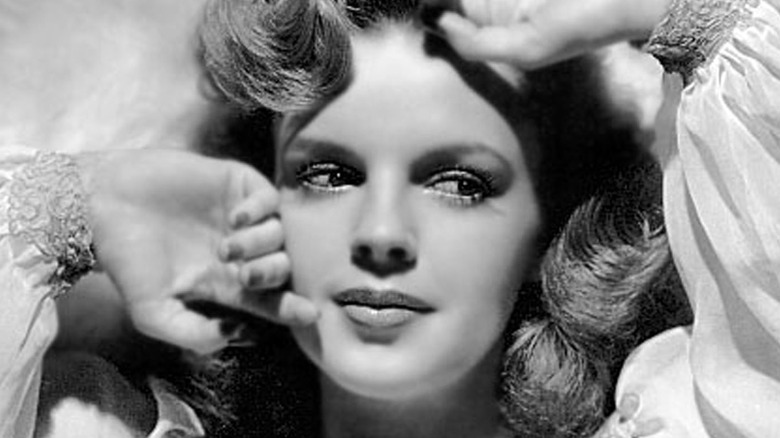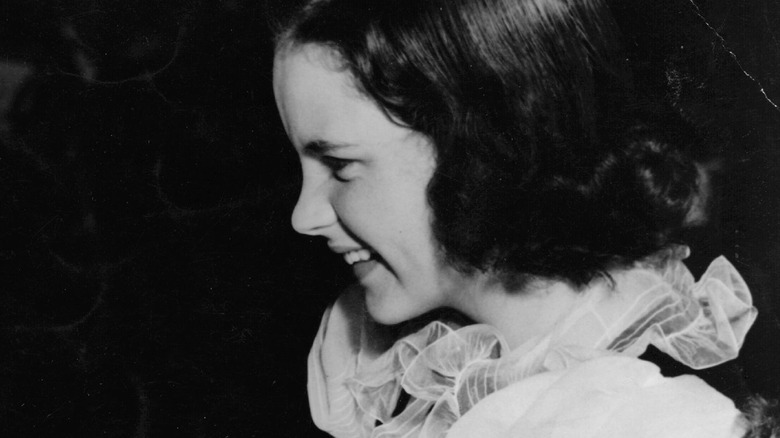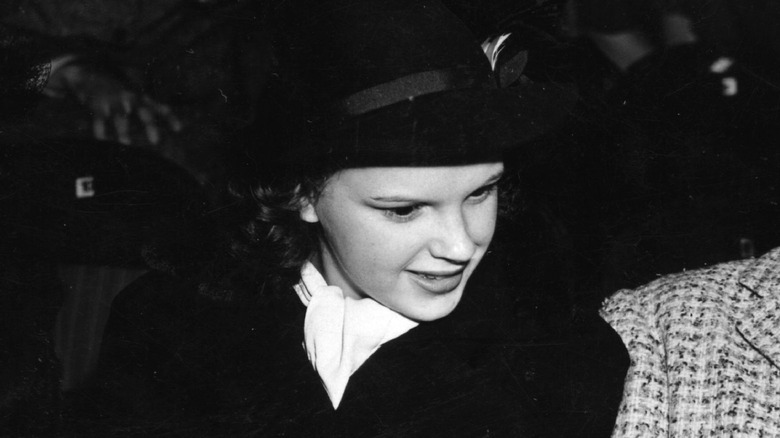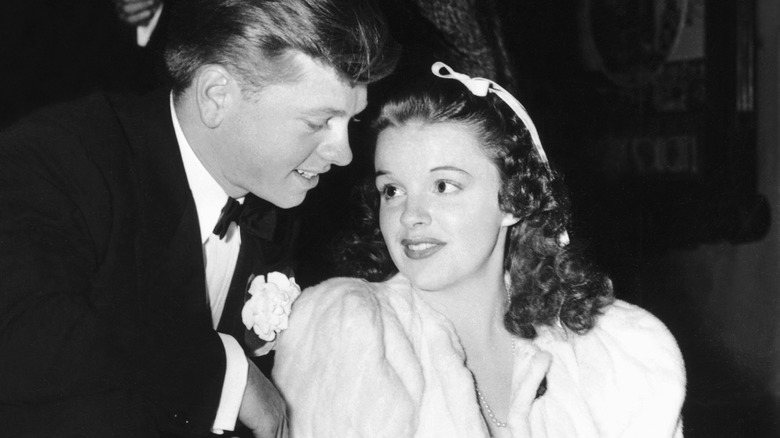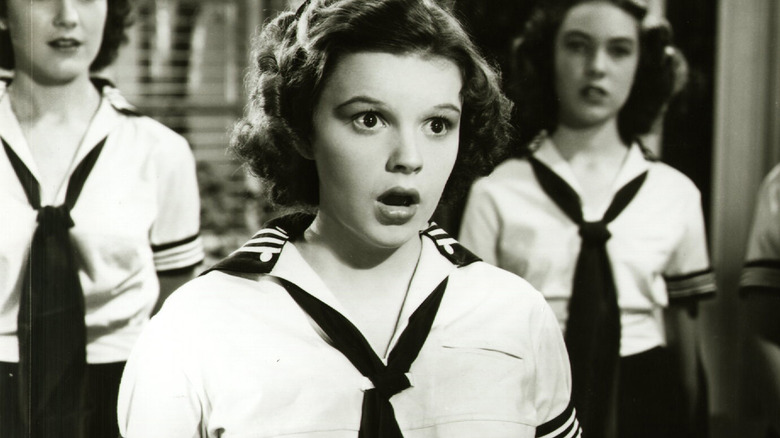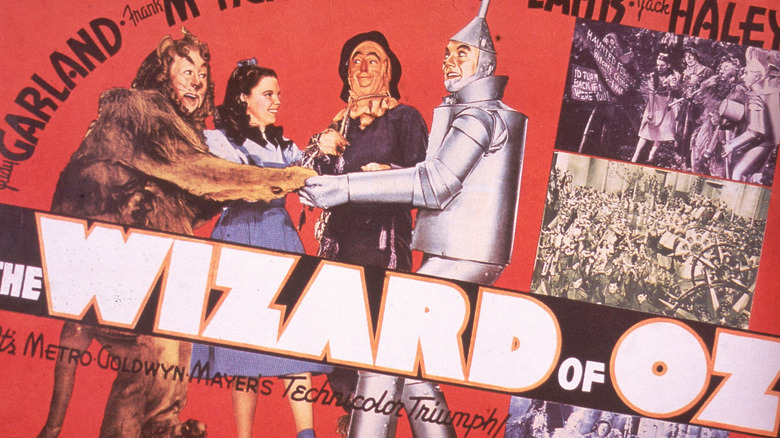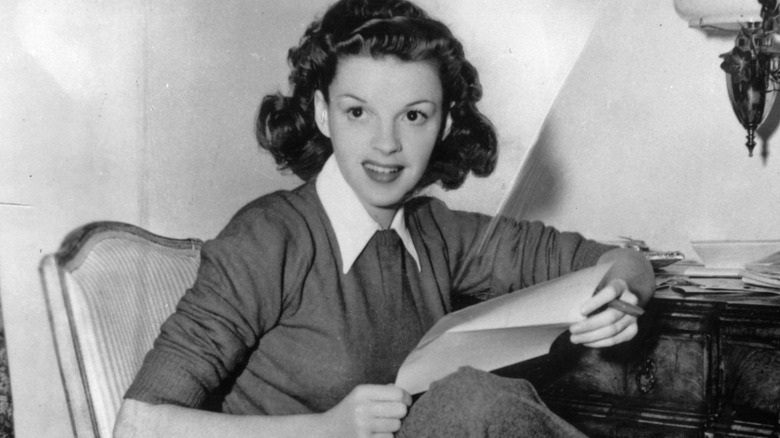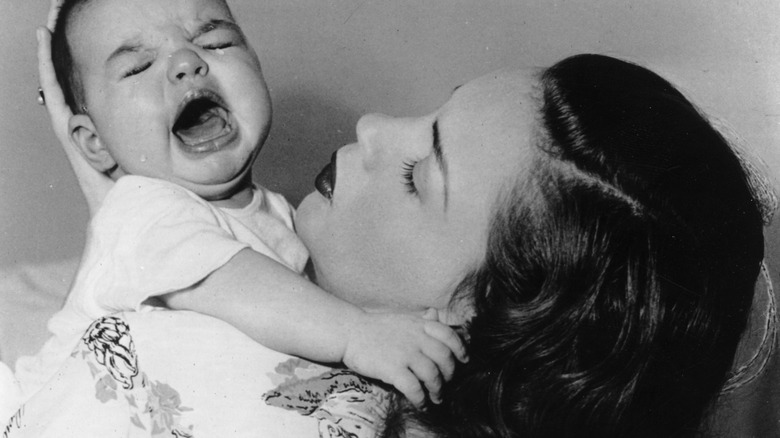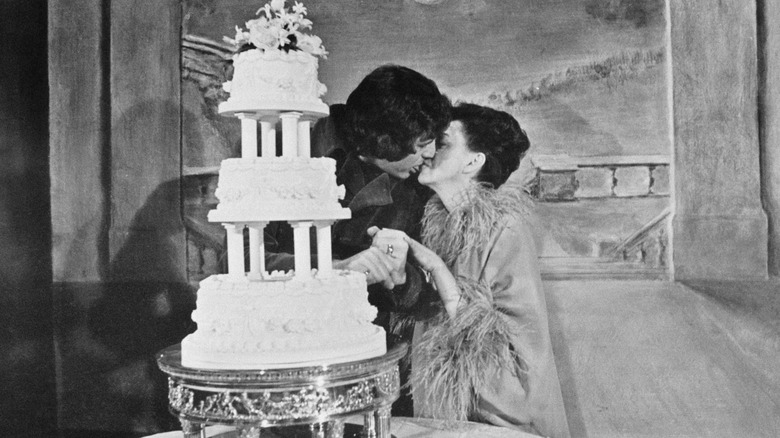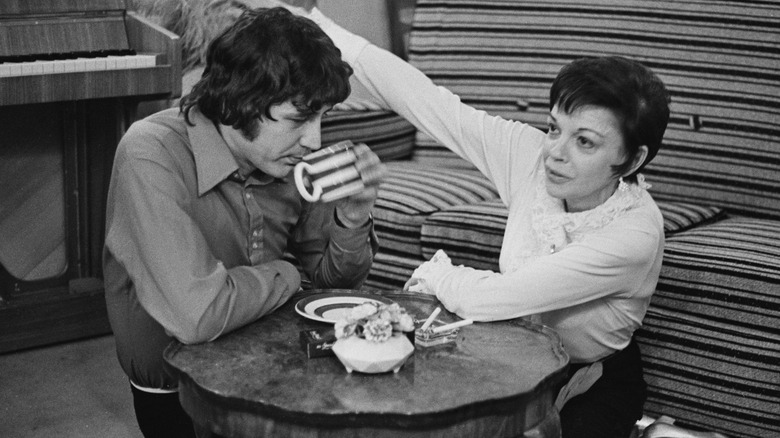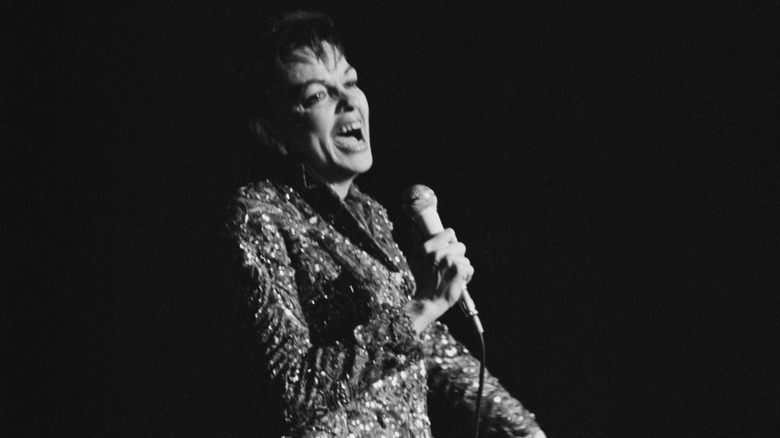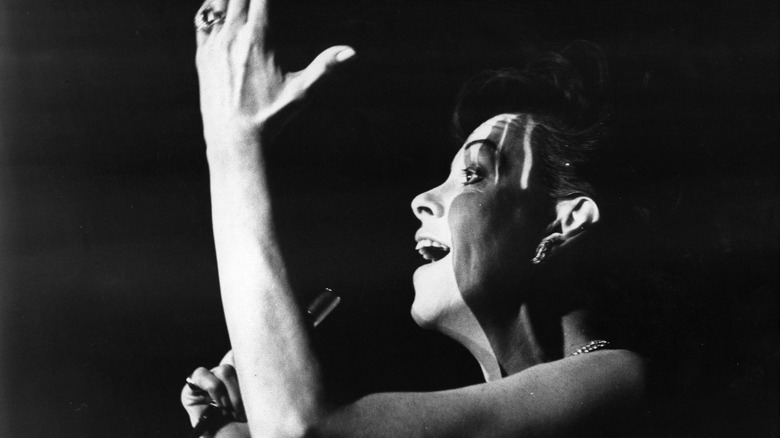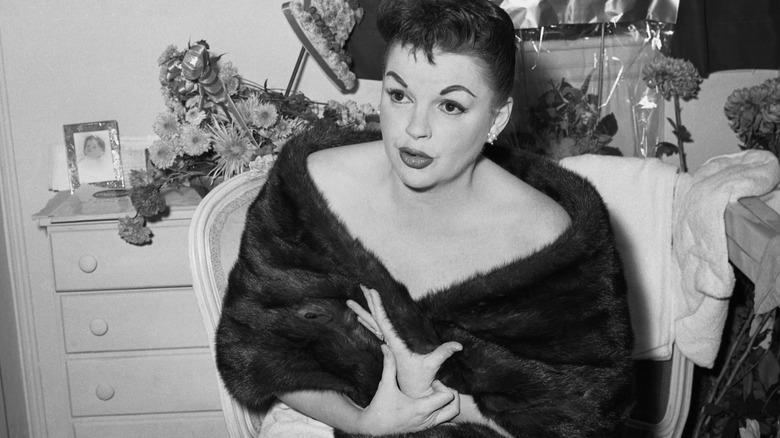Tragic Details About Judy Garland
This article contains triggers for risky substance use, addiction, and mental health struggles.
Judy Garland mesmerized adults and children alike when she stepped into Dorothy's ruby slippers in "The Wizard of Oz" — MGM's 1939 musical based off of the 1900 children's novel "The Wonderful Wizard of Oz." A mere 17 years old when the blockbuster came out, Garland was suddenly shot to the top of the A-list, yet with that fame didn't come much joy. "Sometimes I feel like I'm living in a blizzard," the actor once mused (via Los Angeles Times). "An absolute blizzard."
Truth be told, that blizzard was not much unlike the traumatic and dizzying cyclone that swept Dorothy up at the start of Garland's legendary fantasy flick. Confusion, hopelessness, and a desire for stability plagued Garland throughout her life — something that sadly began at a very young age. Nevertheless, the "Meet Me in St. Louis" star always somehow bounced back; as the Los Angeles Times detailed in 1969, Garland became known as the "queen of the comebacks" in Hollywood — until she couldn't fight anymore.
Garland herself refused to accept defeat in the industry she was thrust in — a testament to her tenacity. "I'm always being painted a more tragic figure than I am," the star declared in 1962 (via Los Angeles Times) — seven years before her untimely death. Yet, taking a look at the details surrounding her life, it's difficult to think otherwise.
Her mother was 'the real Wicked Witch of the West'
Judy Garland didn't live long – 47 years, to be exact. Yet, as she once told Barbara Walters (per the journalist's memoir, "Audition"), she spent 43 years performing, all due to her mother's insistence. According to Biography, it turns out Garland's mother, Ethel Milne Gumm, was quite the pushy stage mom, herself having been a vaudeville performer. In fact, Gumm would even bring Garland to some of her performances, thrusting her on stage alongside her two older sisters.
"She would stand in the wings of the theatre in which we were performing and if I didn't feel good, if I was sick to my tummy, she would say, 'You get out and sing or I'll wrap you around the bedpost and break your a**,'" recalled Garland to Walters, explaining she had no choice but to perform. To make matters worse, this insistence for the limelight started at a young age; Garland "made her theatrical debut" at age 2.
Sadly, Gumm's desire to make her daughter a bonafide star only pushed her away from her peers. As detailed in "Judy Garland on Judy Garland: Interviews and Encounters," the young actor didn't have many friends, as those in show business were considered outcasts. "The only time I felt wanted when I was a kid was when I was on a stage, performing," she once shared.
If you or someone you know may be the victim of child abuse, please contact the Childhelp National Child Abuse Hotline at 1-800-4-A-Child (1-800-422-4453) or contact their live chat services.
Her parents' marriage was very unhappy
Judy Garland was born Frances Ethel Gumm on June 10, 1922. According to Biography, her parents, Ethel Milne and Frank Gumm, didn't plan to have a child — in fact, her mother contemplated an abortion, yet due to the risk that it put on Ethel herself (and the fact that the operation was illegal at the time), the pair ultimately decided to have the baby.
Judy wasn't the first tot for the troubled couple; she had two older sisters: Mary Jane and Virginia. It was alleged that Frank was having "affairs with young men and teenage boys" around the time Ethel became pregnant with her youngest, and the rumors got so out of hand that the family had to move from Grand Rapids, Minnesota, to California in 1926. The move didn't do much to fix the Gumm's marriage. "As I recall, my parents were separating and getting back together all the time," Garland once shared (via Biography). "It was very hard for me to understand those things and, of course, I remember clearly the fear I had of those separations."
However, what the move to The Golden State did do was jumpstart Judy's career. The actor signed with MGM in 1935 — the same year her father died of meningitis. Ethel remarried a mere four years later — on the anniversary of Frank's death, no less — and her relationship with Judy became even more strained afterward, not to mention the actor's disdain for her new stepfather.
Judy Garland's dependency on drugs started early
The pressure to become a performer weighed heavily on Judy Garland ever since she was a little girl. Her mother thrust her in the spotlight when she was still a toddler, and things didn't get better when the young star was taken under MGM's wing in 1935, per Biography. As Garland once told Barbara Walters (via "Audition: A Memoir"), the time she spent on set was "six days a week, sometimes 72 hours at a time."
How was Garland able to perform under such a demanding schedule? Drugs. As explained by History, during Hollywood's Golden Age between the 1920s and '60s, there wasn't any sort of "policy" on drug use in Tinseltown, meaning Hollywood studios fed their stars "pep pills" to keep them going, followed by a different set of drugs to help them sleep. Garland's addiction started early, while she was still a child star. According to Biography, by the time she was 17 and filming for "The Wizard of Oz" was complete, "she was already addicted to barbiturates and amphetamines."
Garland once shared her disturbing schedule (via PBS), noting that while filming, she was required to take these "pep pills," and would then be given sleeping pills that would knock her out for four hours, only to be woken up again with even more drugs to resume shooting. "That's the way we got mixed up," she recalled.
If you or anyone you know is struggling with addiction issues, help is available. Visit the Substance Abuse and Mental Health Services Administration website or contact SAMHSA's National Helpline at 1-800-662-HELP (4357).
MGM bullied her about her weight
If the childhood traumas Judy Garland suffered weren't enough, she had to deal with dehumanizing comments about her weight, too. After signing with MGM in 1935, the young star was expected to appear in her first feature flick the following year, titled "Pigskin Parade." She was only 14 (via Biography). To make sure she was camera-ready, studio head Louis B. Mayer demanded Garland's diet consisted of "chicken soup, black coffee, and cigarettes, along with pills to reduce her appetite."
As detailed in "Get Happy: The Life of Judy Garland," after "Pigskin Parade" came out, Garland was calling herself as "a fat little frightening pig with pigtails" — an image of herself she surely developed thanks to MGM. Mayer referred to his A-lister as "my little hunchback," a "joke" Garland often quipped herself, too. It didn't help that the press wasn't forgiving, either, and at one point, the New York Post even began calling the actor "plump Judy Garland." Garland has said that above anything else in her childhood, the "constant struggle" regarding food was what she remembered the most.
Sadly, Garland's body image issues followed her into adulthood. As her third husband, Sid Luft, recalled in his book, "Judy and I," she never gave up her obsessive desire to be "camera slim" — even if it meant using dangerous methods.
If you are struggling with an eating disorder, or know someone who is, help is available. Visit the National Eating Disorders Association website or contact NEDA's Live Helpline at 1-800-931-2237. You can also receive 24/7 Crisis Support via text (send NEDA to 741-741).
Filming The Wizard of Oz was a traumatizing experience
There's no doubt "The Wizard of Oz" was Judy Garland's most iconic role. The 1939 flick solidified Garland as a pop culture legend — but at what cost? According to Far Out, along with being placed on a strict diet and amphetamines (the latter led to a life-long addiction), she was also slapped by director Victor Fleming when she stumbled through a scene.
But Fleming was a bit player in a much more problematic establishment. As biographer Gerald Clarke told ABC News, Garland was sexually assaulted by the higher-ups at MGM — a horror that began while shooting "The Wizard of Oz." The worst perpetrator was studio head Louis B. Mayer. According to Clarke, Mayer would compliment Garland's singing, saying, "you sing from the heart." Then, "he would place his hand on her left breast and say 'this is where you sing from.'" The molestation lasted for four years until Garland finally stood up for herself, which resulted in Mayer crying. "I often thought I was lucky that I didn't sing with another part of my anatomy," Garland mused (via "Get Happy: The Life of Judy Garland").
"I've always taken 'The Wizard of Oz' very seriously," the actor herself later reflected (via "Judy Garland on Judy Garland"). "I believe in the idea of the rainbow. And I've spent my entire life trying to get over it."
If you or anyone you know has been a victim of sexual assault, help is available. Visit theRape, Abuse & Incest National Network website or contact RAINN's National Helpline at 1-800-656-HOPE (4673).
MGM fired Judy Garland after a 'nervous breakdown'
Growing up under MGM's wing was a far cry from the typical youth Judy Garland craved. As shockingly detailed by "When Doctors Kill: Who, Why, and How," from 1939 to 1948, Garland filmed 21 movies — all with her daily cocktails of "pep pills" and sleeping pills.
As a result, the star's work suffered. Per PBS, the medications had Garland struggling to get through her lines and musical numbers. She started turning up to set late (or not at all), ultimately holding up productions — a bad look for MGM and one of its biggest stars (via CBS). Besides being detrimental to the young actor's physical health, this routine took a toll on her mentally, as well. According to "When Doctors Kill," while filming "The Pirate" in 1947, "Garland suffered a nervous breakdown" and was put in a "private sanitarium." Things only got more alarming from there, and by the time she was in her mid-20s, Garland was receiving "electroshock therapy for depression."
By 1950, Garland's relationship with MGM was on thin ice. The actor was "suspended" from filming the musical "Annie Get Your Gun," leading to more electroshock therapy and an annoyed Louis B. Mayer who reportedly moaned, "I've got millions tied up in this girl, I need her to work." After a few more on-set stumbles that year, MGM studios officially fired Garland on June 17.
If you or anyone you know is struggling with addiction issues, help is available. Visit the Substance Abuse and Mental Health Services Administration website or contact SAMHSA's National Helpline at 1-800-662-HELP (4357).
Her relationship with her children was turbulent
There's no denying that Judy Garland lacked a normal childhood. Because of this, the legendary actor truly wished her kids didn't have to go through the same traumas. "My children are the most important things in my life," she once declared (via "Judy Garland on Judy Garland"), adding that they were "far more important" than "anything else" in her life. Garland had three children: Liza Minnelli in 1946, Lorna Luft in 1952, and Joey Luft in 1955 (via Country Living).
Try as Garland might to put her children first, she was still battling her own demons — something that continued until her tragic death in 1969. According to The New York Times, Minnelli was treated as an adult early on in her life, becoming her mother's source of "comfort and advice" by the time she was a teen. It was Minnelli as well who dealt with most of the problems, too, from "unpaid bills" to "missed appointments." As for Lorna and Joey, the younger siblings had to deal with their mother's dwindling source of income. By 1967, they were broke. Lorna told People of an incident that occurred that year: she was coming back from school to see her mother sitting on a hotel's window ledge. "We can't pay the hotel bill, so I'm threatening to jump out the window," Garland allegedly told her.
"I was powerless," Joey told Closer in 2017, noting that while all three siblings truly thought highly of their mother, nothing could have helped her addiction.
Judy Garland had a tragic love life
Out of all of the loves Judy Garland had in her life, none of them seemed to last. Sadly, four of the star's marriages ended in divorce, with the fifth tragically cut short due to her death. As noted by Town & Country, Garland's first marriage was to David Rose in 1941 — a shock at the time due to the star only having been 19, while Rose was 31. Of course, MGM disapproved of this union, yet Garland was determined, eloping in Las Vegas. After a "secret abortion" and the couple's inability to see eye to eye, the pair divorced in 1944.
Next up was director Vincent Minnelli in 1945 — a coupling Garland's studio finally approved of. In fact, according to Town & Country, it was studio head, Louis B. Mayer himself who walked the blushing bride down the aisle. However, with the star's growing instability, the pair parted ways in 1949, making room for her third husband, Sid Luft — and what was to become her longest marriage. Luft and Garland married in 1952, yet, for similar reasons that drove the star and Minnelli apart, this union also came to a close in 1965. A "whirlwind romance" to fourth husband, Mark Herron, happened that same year, sadly only lasting until 1967.
Garland's final and shortest marriage was to Mickey Deans in 1969. By now, the actor struggled with various physical and mental ailments, ultimately leading to her fatal overdose a mere three months after her wedding date (via Town & Country).
She had multiple suicide attempts
It's only natural that Judy Garland's mental health severely deteriorated as a result of her grueling schedule and severe mental traumas given to her by way of her mother and the production company she signed to, MGM. Sadly, the star "tried suicide countless times," as the Los Angeles Times detailed.
According to "When Doctors Kill: Who, Why, and How," Garland made her first attempt in 1947 while filming "The Pirate," alongside Gene Kelly. As the book explains, this was after her first "nervous breakdown" that resulted in being placed in a mental health institution. Instead of getting Garland the help she needed, her mother, Ethel Milne Gumm, "taped up the cuts" from her daughter's slashed wrists and had her resume the musical's filming. More attempts followed, as detailed by her daughter Lorna Luft's biography, "Me and My Shadows." Luft revealed many harrowing stories, including her mother's postpartum depression (which resulted in an overdose), another attempt while in a Washington hotel room, and yet another incident where she tried "[throwing] herself out of a hotel window." Remarkably, Luft claims that none of those closest to the actor ever believe she intentionally tried to take her own life.
"My mother's suicide attempts were a way to release anxiety," explained Luft, adding that some of the occurrences were "drug reactions" that she wouldn't remember afterward.
If you or anyone you know is having suicidal thoughts, please call the National Suicide Prevention Lifeline at 1-800-273-TALK (8255).
Her final on-stage performances were heartbreaking to watch
The final years of Judy Garland's life were not filled with glitz and glam — the sort of end you'd expect from such a Hollywood legend that left her impact on the industry. Heartbreakingly enough, things only escalated even further.
Garland's daughter, Lorna Luft, spoke about her mom's financial struggles in her memoir, "Me and my Shadows," noting that thanks to agents, the IRS, no-show concerts, and "old debts," Garland was completely broke. And yet, because the "Wizard of Oz" star was so used to a certain way of living, "she had no idea what things cost or how to keep a track of her money." Even as eviction notices came the family's way, Garland would perform various dramatic stunts as a means to get out of seemingly desperate situations.
In 1968, a year before her death, Garland embarked on a string of concerts in London, England (via Time). According to The Guardian, these shows were difficult to watch, what with the star's slurred speech and heckling of the audience. "The shoddy, tarnished world that created her has emasculated her," wrote journalist Tony Palmer. "It's pathetic and lonely and dignified."
She died of a drug overdose
Sadly, after having been fed various forms of pills practically her entire life, Judy Garland finally died of a drug overdose on June 26, 1969 (via The Guardian). She was only 47. According to PBS, it was Garland's fifth husband of three months, Mickey Deans, who discovered his wife "slumped on the toilet with her hands still holding up her head."
Of course, an autopsy was performed, and it was quickly discovered that the actor's cause of death was accidental "barbiturate poisoning." According to the coroner who carried out the autopsy, Dr. Gavin Thurston, Garland also had "cirrhosis of the liver" — meaning that the amount of alcohol the star had been drinking would have killed her as well had it not been for the drugs. As Thurston told the Desert Sun at the time, he firmly believed the cause of death wasn't deliberate. "This is quite clearly an accidental circumstance to a person who was accustomed to taking barbiturates over a very long time," he declared.
However, Garland's eldest daughter, Liza Minnelli, firmly disagrees that her mother died of an overdose. "She let her guard down," Minnelli told Time in 1972. "I think she just got tired."
If you or anyone you know is struggling with addiction issues, help is available. Visit the Substance Abuse and Mental Health Services Administration website or contact SAMHSA's National Helpline at 1-800-662-HELP (4357).
Was Judy Garland bipolar and undiagnosed?
Of course, it would be impossible to claim Judy Garland's lifelong problems with addiction didn't contribute to her mental health struggles. According to The New York Times, after five husbands, "at least" 20 attempts at taking her own life, hospitalizations, and even the harrowing studio-ordered electroshock therapy, it's no wonder Garland struggled as much as she did throughout her life. Yet, was something else plaguing her as well?
While there are no documented reports of the "Summer Stock" actor suffering from any confirmed mental illness, some have alleged the star may have been bipolar. "The SAGE Encyclopedia of Intellectual and Developmental Disorders" notes a "link between bipolar disorder and creativity," citing many famous artists who have supposedly struggled with the illness — including Garland. "The Bipolar Express" goes even further, noting that because the actor was purportedly suffering from the disorder, it only exacerbated her prescription pill addiction.
Whether or not Judy Garland had undiagnosed bipolar disorder, one thing remains certain: the star lived an incredibly tragic life. Still, her legacy remains unwavering. "You can't ever get in the way of talent like my mom's," declared Garland's daughter, Liza Minnelli, to CBS. "No matter what people said, or what people did, or what drama was created, or what was going on. That talent will come through again, and again, and again."
If you or someone you know is struggling with mental health, please contact the Crisis Text Line by texting HOME to 741741, call the National Alliance on Mental Illness helpline at 1-800-950-NAMI (6264), or visit the National Institute of Mental Health website.
